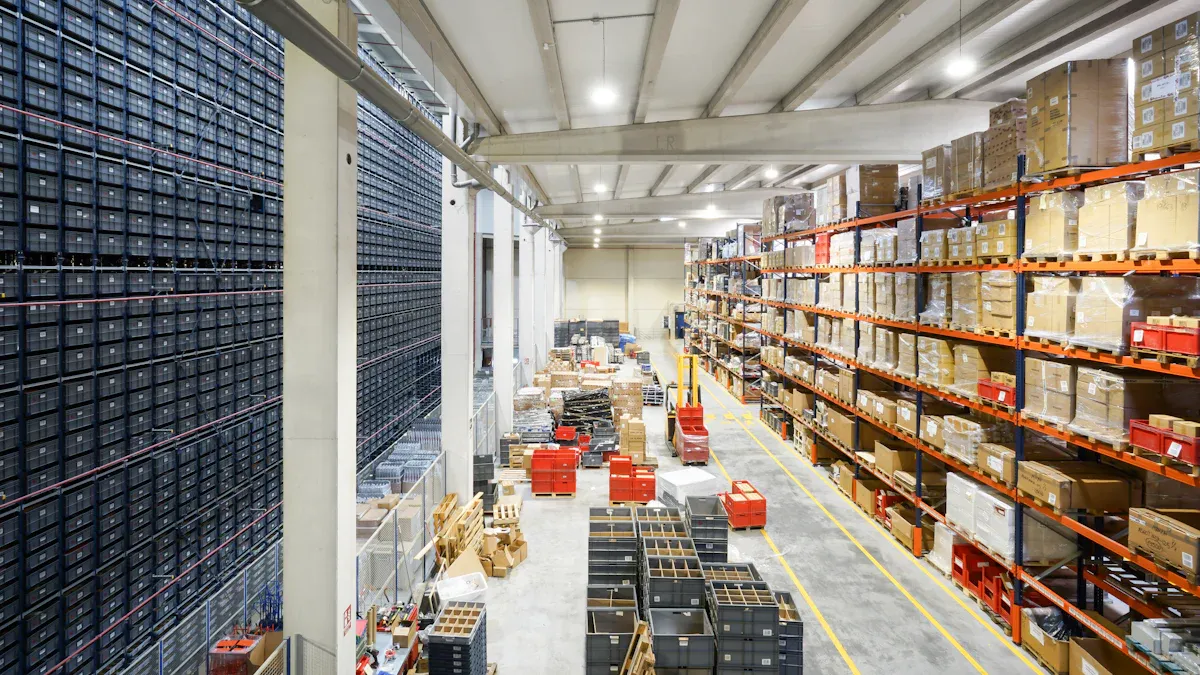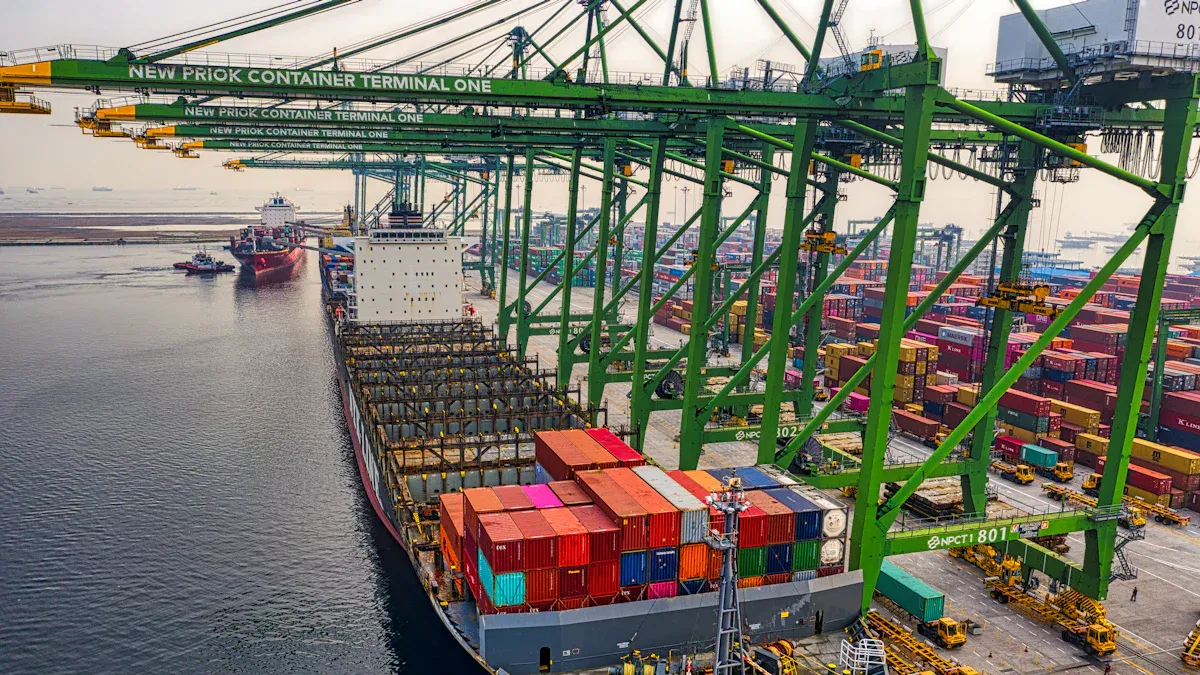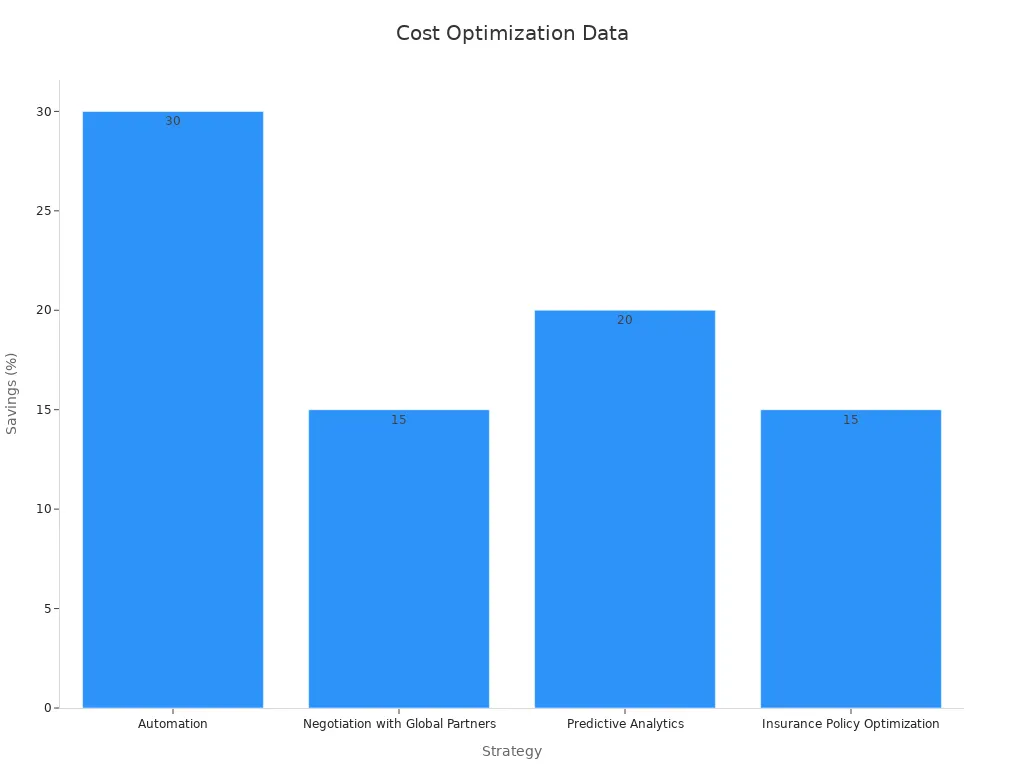Cross-border E-commerce Logistics Explained for Online Sellers

Cross-border e-commerce logistics connects your business to buyers worldwide. You face customs, shipping, returns, and compliance. The cross border e-commerce market will reach $1,000 billion by 2034, with Asia-Pacific leading. Expanding sales channels increases cross border logistics complexity and costs. JUSDA helps you master international ecommerce with efficient cross border e-commerce solutions.
Key Takeaways
Cross-border e-commerce logistics connects your business to global customers but requires careful management of customs, shipping, and returns to avoid delays and extra costs.
Using advanced technology and choosing reliable logistics partners like JUSDA can improve tracking, reduce errors, and speed up delivery, helping you grow internationally with confidence.
Clear communication, smart cost control, and strong compliance with local rules build customer trust and keep your cross-border business competitive and efficient.
What Is Cross-border E-commerce Logistics?

Cross-border e-commerce logistics refers to the process of moving goods internationally for online transactions. You handle shipments between businesses and consumers, businesses and other businesses, or even private individuals. This process covers the entire value chain, from overseas suppliers to domestic retailers and finally to customers. Cross-border e-commerce logistics reduces trade barriers and supports trade growth, especially in regions with strong infrastructure and e-commerce regulations.
Key Elements
To succeed in cross border e-commerce, you need to manage several critical elements:
Meticulous customs and duties management, including accurate documentation and compliance with import regulations.
Multiple shipping carriers for comparing rates and delivery times, which helps you optimize costs and efficiency.
Advanced technology and automation, such as real-time tracking and order processing software, to reduce errors.
Strategic partnerships with experienced third-party logistics providers to expand your global reach.
Inventory management using predictive analytics to balance stock and meet demand.
Real-time supply chain transparency for proactive logistics management.
Localized customer service, including language support and market-specific adaptations, to build trust.
Tip: Building trust through transparency about costs, delivery times, and return policies can set your cross-border ecommerce marketplace apart.
Why It Matters
Cross-border ecommerce logistics plays a vital role in expanding your international ecommerce business. Rising populations and urbanization increase demand for goods across borders. Higher incomes and a growing middle class drive more cross-border ecommerce sales. Efficient logistics help you meet these demands by ensuring fast, reliable delivery and smooth customs clearance. Technology like AI and blockchain improves security, transparency, and operational efficiency. When you adapt your logistics to each market, you reduce returns and boost customer satisfaction, making your cross border e-commerce business more competitive.
Cross-border Ecommerce Logistics Challenges

Customs & Compliance
You face complex customs and duties management every time you ship internationally. Each country has its own customs regulations, which means you must prepare accurate documentation for every shipment. Mistakes in paperwork or misunderstanding local rules can lead to delays, fines, or even confiscation of goods.
Customs and duties management involves handling commercial invoices, packing lists, and certificates of origin.
You must comply with global standards like CTPAT and GDPR, as well as country-specific rules such as USMCA or REACH.
Cross-border ecommerce shipments require more paperwork than domestic ones.
Technology and customs brokers can help you automate processes and reduce errors.
Note: Customs compliance programs and bilingual communication are essential for smooth cross-border operations.
Shipping & Delivery
Cross-border shipping brings its own set of challenges. About 73% of sellers report issues with international package delivery. Delays often happen because of customs checks, long transit distances, and multiple carriers handling your goods.
Packages may get damaged due to extended transit times.
Tracking becomes less accurate as shipments change hands across borders.
Currency fluctuations and language barriers can complicate coordination.
Reliable transportation partners are hard to find.
These problems can hurt customer satisfaction. You can improve results by using better tracking technology and building strong local partnerships.
Costs & Returns
Managing costs and returns in cross-border ecommerce is difficult. Customs and duties management adds extra fees, and fluctuating shipping costs make pricing unpredictable.
Returns are complicated by different customer protection laws and customs procedures.
High return shipping expenses can reduce your profit margins.
Each market may have unique requirements for refunds and returns.
You need a clear returns policy and efficient logistics to keep costs under control and customers happy.
Setup Guide for Cross Border E-commerce
Expanding your online business internationally requires a clear plan for cross border logistics. You need to make smart decisions at every step to ensure smooth operations, cost control, and customer satisfaction. Here’s how you can set up your cross border e-commerce logistics for success.
Market Selection
Choosing the right markets is the first step in your cross border e-commerce journey. Start by researching demand for your products in different countries. Look at local buying habits, popular platforms, and competitor presence. Consider language, currency, and payment preferences.
Follow these steps to select your target markets:
Analyze sales data and online trends to spot high-potential regions.
Check local regulations and import restrictions for your product category.
Evaluate shipping costs, delivery times, and available cross-border shipping options.
Assess the ease of returns and after-sales support in each market.
Prioritize markets where you can offer competitive pricing and fast delivery.
Tip: JUSDA’s global network and local expertise can help you identify and enter promising markets with tailored cross border logistics solutions.
Documentation & Compliance
Every country has its own rules for cross border e-commerce. You must prepare the right documents and follow local laws to avoid delays or penalties.
Here’s a quick overview of key documentation and compliance requirements in major regions:
Region/Market | Key Documentation & Compliance Requirements | Notable Features & Timelines |
|---|---|---|
United States | Consumer protection focus; digital asset regulation; data security incident reporting | Emphasis on fintech transparency; evolving digital asset oversight |
European Union | Digital Services Act; Corporate Sustainability Due Diligence Directive; ESG disclosures | Detailed, phased implementation; strong sustainability focus |
Asia-Pacific (Australia & Japan) | Australia: climate disclosures; Japan: Product Safety Act, voluntary sustainability standards | Regional adaptation; mix of mandatory and voluntary disclosures |
You should always:
Prepare commercial invoices, packing lists, and certificates of origin.
Stay updated on changing regulations, especially for data privacy and product safety.
Use digital tools to automate document preparation and reduce errors.
Work with experienced customs brokers or logistics partners like JUSDA to streamline compliance.
Note: The pharmaceutical sector faces extra challenges due to non-uniform regulations. Technology and harmonization efforts help reduce inefficiencies and speed up compliance.
Shipping Partners
Selecting the right shipping partners is critical for reliable cross border logistics. The best partners help you manage costs, reduce errors, and deliver on time.
When evaluating shipping partners, consider these factors:
Proven track record with strong customer references.
High on-time delivery rates and low shipping error rates.
Fast claims processing and high claim resolution rates.
Advanced technology for tracking and warehouse management.
Flexible and scalable services to match your business growth.
Strong customs clearance capabilities and local carrier coordination.
Transparent pricing and clear service level agreements.
Commitment to sustainability and excellent customer service.
JUSDA stands out as a global supply chain expert. With over 155 service points worldwide, advanced technology, and a robust network, JUSDA offers end-to-end shipping solutions that optimize your cross border logistics from warehouse to customer doorstep.
Returns Management
Managing returns in cross border e-commerce can be complex, but a clear strategy builds trust and loyalty.
Best practices for returns management include:
Offer customer support in local languages and ensure 24/7 availability.
Create clear, market-specific return policies that comply with local laws.
Use accurate HS codes and prepare correct shipping documentation to avoid customs delays.
Partner with reliable logistics providers for smooth returns and competitive rates.
Place inventory in regional warehouses to speed up returns and lower costs.
Monitor return rates and reasons, then adjust your processes to reduce defects and fit issues.
Use software tools to automate return management and keep customers informed throughout the process.
Callout: The average ecommerce return rate ranges from 20% to 30%. Clear policies and efficient logistics can turn returns into opportunities for customer satisfaction.
JUSDA’s integrated cross border logistics solutions help you manage returns efficiently, from local drop-off points to centralized warehouses, ensuring a seamless experience for your customers.
Technology in Cross Border Logistics
Technology drives success in cross-border e-commerce logistics. You need smart platforms and real-time tracking to keep your supply chain efficient and transparent. JUSDA’s JusLink platform brings these innovations together, giving you a competitive edge.
Smart Platforms
Smart logistics platforms help you manage complex international operations with ease. You can use data analytics and automation to improve every step of your supply chain.
NetworkON uses analytics to cut urban delivery times by up to 20%. This improves route planning and saves fuel.
Amazon’s predictive delivery tools reach over 95% accuracy, which boosts customer satisfaction.
Locus’s AI dispatch system increases on-time deliveries by 25% through better timing and routing.
Advanced tracking systems show customs milestones and multi-carrier updates, reducing delays.
Predictive models help you forecast demand, position inventory, and schedule labor, which shortens lead times and lowers costs.
Unified dashboards bring together data from all your sales channels, so you keep your brand experience consistent.
Smart platforms like Cainiao’s eHubs use automation and AI to speed up customs clearance and regional distribution, helping you move goods faster and more reliably.
Real-time Tracking
You need real-time tracking to see where your shipments are at every moment.
RFID, IoT, and blockchain technologies give you secure, real-time data.
These tools help you make quick decisions and control your logistics flow.
Real-time tracking reduces losses and improves shipment visibility.
Cloud-based portals connect transport companies, devices, and suppliers for better coordination.
Tracking and tracing devices increase safety, transparency, and operational efficiency.
JUSDA JusLink Integration
JUSDA’s JusLink platform combines smart technology and real-time tracking for your cross-border logistics. JusLink uses IoT, cloud computing, and big data to give you full visibility and control. You can track shipments, manage inventory, and coordinate with partners—all in one place. JusLink’s AI-driven insights help you optimize routes, reduce costs, and deliver orders on time. With JusLink, you gain the confidence to expand globally and meet customer expectations every step of the way.
JUSDA Solutions for Cross-border Ecommerce
China-Europe Express Rail
You can move goods between China and Europe faster and more affordably with JUSDA’s China-Europe Express Rail. This service bridges the gap between air and sea freight, offering door-to-door delivery in just 15–20 days. Many businesses have already seen real benefits:
A major automotive supplier reduced freight costs by 10% and cut transit time by 45 days by switching from ocean to rail.
GPS tracking gives you better freight visibility.
Multi-mode flexibility lets you use air freight only when needed.
Metric | Data |
|---|---|
Total trips completed (10 years) | |
Total goods transported | Approximately 7.5 million tons |
Growth in frequency | From 1 train/month to 34 trains/week |
Key operational advantages | Punctuality, track and trace, reliable door-to-door delivery |
Academic studies show that the China-Europe Express Rail boosts economic growth in many cities, making it a smart choice for your cross-border shipping solutions.
End-to-End Services
JUSDA gives you a full range of logistics services, from procurement to last-mile delivery. You benefit from a smart logistics platform that uses AI and cloud computing to digitize every step—procurement, transportation, warehousing, and customs clearance. JUSDA has earned industry recognition, including honors at the China International Import Expo for four years and a spot on the 2024 Logistics and Supply Chain Solutions list. You get reliable, flexible, and expert support for seamless global expansion.
Industry-specific Solutions
You can trust JUSDA to tailor solutions for your industry. Whether you work in electronics, automotive, FMCG, or healthcare, JUSDA adapts its services to your unique needs. The company’s experience across many sectors ensures you get efficient, compliant, and scalable logistics support.
Success Tips for Cross Border Logistics
Compliance Best Practices
You need to treat compliance as a core part of your business strategy. Companies that use strategic compliance see better results and fewer risks. For example, 70% of risk professionals now focus on integrating compliance with business goals. Over 80% say compliance guides their decisions. Automated tools and clear checklists help you stay on track and avoid costly mistakes. High compliance rates, above 90%, link to fewer problems and better outcomes. Many organizations now invest more time and resources in compliance, with 60% reporting increased efforts. The table below shows how top companies approach compliance:
Compliance Best Practice | Outcome/Statistic |
|---|---|
Strategic Compliance Integration | 70% shift from basic to strategic compliance |
Compliance in Decision-Making | 83% see compliance as essential |
Automation and Regtech Use | 62% spend less time tracking regulations |
Outsourcing Compliance Functions | 38% outsource some or all compliance tasks |
Confidence in Managing Risks | 60% feel confident in compliance management |
Tip: Use digital guidelines and automated tracking to boost compliance and reduce errors.
Customer Communication
Clear communication builds trust in cross-border logistics. You should always keep customers informed about their shipments. When delays happen, acknowledge them and explain the reasons, such as customs or paperwork issues. Guide customers on what to expect next. Address common concerns like shipment location, ETA changes, and tariff costs. Use these proven strategies:
Proactive multi-language notifications through SMS, email, or app.
Dynamic delivery options at checkout for speed or cost.
Personalized shipping experiences based on customer data.
Customers value transparency. Regular updates and clear instructions reduce confusion and improve satisfaction.
Cost Optimization
You can lower costs and boost efficiency with the right strategies. Automation cuts labor costs by up to 30%. Negotiating with global partners can save you 15% on transportation. Predictive analytics help you optimize routes, reducing logistics expenses by nearly 20%. Insurance policy optimization also trims claims costs by 15%. The chart below shows savings from different approaches:

Invest in overseas warehouses to speed up delivery and improve customer satisfaction. Stay flexible and ready to adapt to disruptions, such as those caused by the COVID-19 pandemic. Effective shipping strategies help you stay competitive and resilient in a changing market.
Choosing a Logistics Partner
What to Look For
Selecting the right logistics partner shapes your cross-border e-commerce success. You need a provider who matches your business needs and supports your growth. Focus on these key criteria:
Criteria | What It Means for You |
|---|---|
Integration with your systems, real-time tracking, and cloud-based inventory tools. | |
Geographic Coverage | Fulfillment centers in your target markets to cut shipping times and costs. |
Ability to scale services as your business grows or changes. | |
Customer Service Quality | Fast, responsive support and clear communication. |
Proven track record and ability to handle market changes. | |
Returns Processing | Efficient handling and restocking of returned products. |
Shipping Speed | Fast delivery and same-day order processing. |
Reputation | Positive reviews and strong industry presence. |
You should also look for partners with strong safety standards, experience with fragile or bulky items, and value-added services like kitting or customization. A global presence and 24/7 support help you manage issues quickly and expand into new markets.
Questions to Ask
Before you commit, ask potential logistics partners the right questions. This helps you understand their strengths and fit for your business:
What types of products do you specialize in handling?
Can you process orders the same day and meet fast delivery targets?
How do you manage returns and restocking?
What technology do you use for tracking and inventory management?
Do you have fulfillment centers in my target markets?
What is your shrinkage allowance for lost or damaged goods?
How do you handle seasonal spikes or sudden growth?
Are there minimum order volumes or extra fees?
What guarantees and compensation do you offer for errors?
How do you ensure compliance with international regulations?
Tip: A strong logistics partner answers these questions clearly and shows flexibility, reliability, and a commitment to your business goals.
Case Study: Sharp & JUSDA
Challenges
You face many obstacles when managing global supply chains. Sharp, a leading home appliance brand, encountered several common industry problems as it expanded internationally.
Shipping costs increased due to global demand and limited container availability.
Port congestion caused delays and made delivery times unpredictable.
Container shortages forced companies to compete for space, raising prices even more.
Freight rates, such as those from Asia to the US West Coast, rose by 3% to $2,462 per FEU, according to Freightos Terminal data.
These issues made it hard for Sharp to keep inventory levels steady and meet customer expectations.
Solutions
Sharp partnered with JUSDA to transform its supply chain. You can see how a strategic approach makes a difference. JUSDA introduced a software and hardware solution that covered procurement, production, and recycling. The JusLink platform gave Sharp real-time visibility into shipments and inventory. JUSDA also streamlined customs clearance and coordinated with multiple carriers. This approach reduced manual work and improved communication between Sharp’s teams and suppliers.
Results
You benefit from measurable improvements when you use a smart logistics partner. Sharp saw a 20% drop in logistics costs and a 70% reduction in labor expenses. Order delivery times improved by 30%, and operational efficiency increased by 50%. The table below highlights these gains:
Metric | Improvement |
|---|---|
Logistics Costs | -20% |
Labor Costs | -70% |
Order Delivery Time | +30% |
Operational Efficiency | +50% |
Sharp’s experience shows that the right logistics partner can help you overcome global shipping challenges and achieve lasting growth.

JUSDA Solutions
To provide you with professional solutions and quotations.
You now understand cross-border e-commerce logistics and how to overcome its challenges. Use technology to streamline your operations. Choose a reliable partner like JUSDA for global growth. Reach out to JUSDA or explore the China-Europe Express Rail to take your business to the next level.
See Also
Revealing New Approaches To Supplier Partnerships In Global E-commerce
How Supply Chain Transparency Drives Success In Worldwide E-commerce
Transforming Supply Chain Operations Through Cloud Technology Innovations
Achieving Growth In International Trade Using JUSDA Solutions
Shaping Tomorrow’s Logistics Through Advanced Digital Technologies
